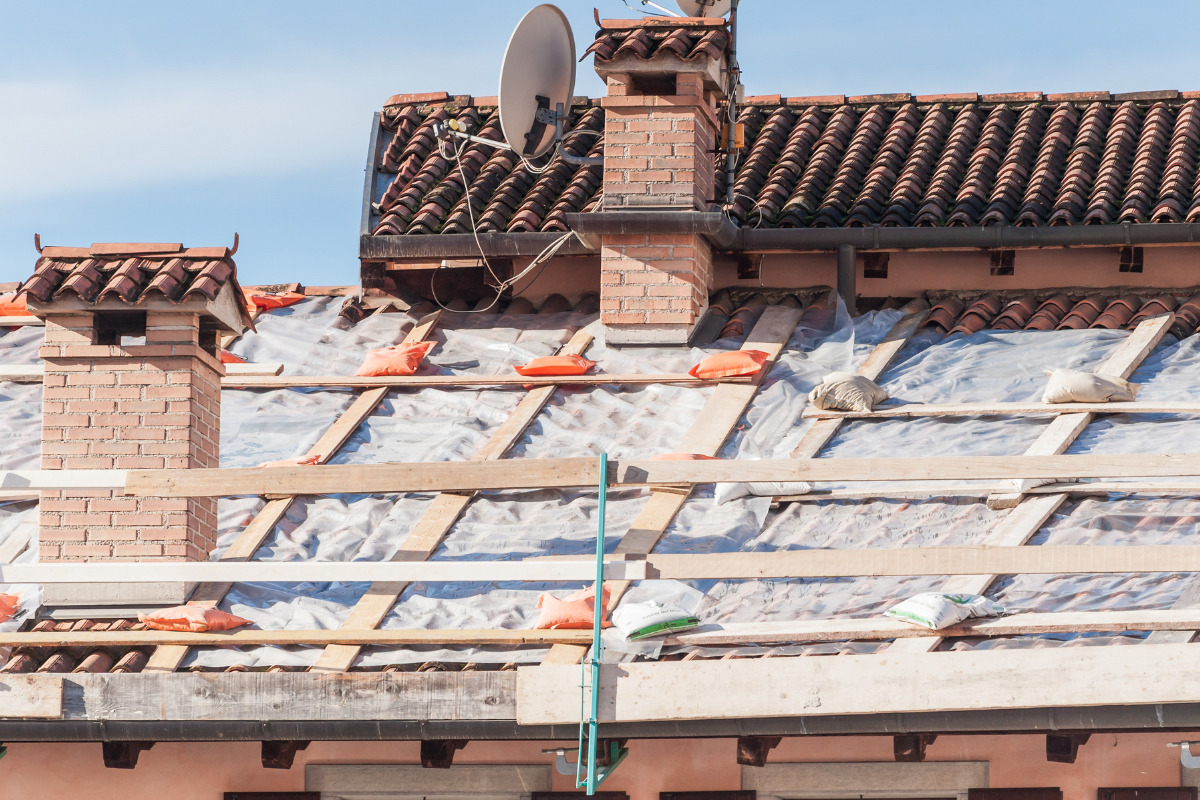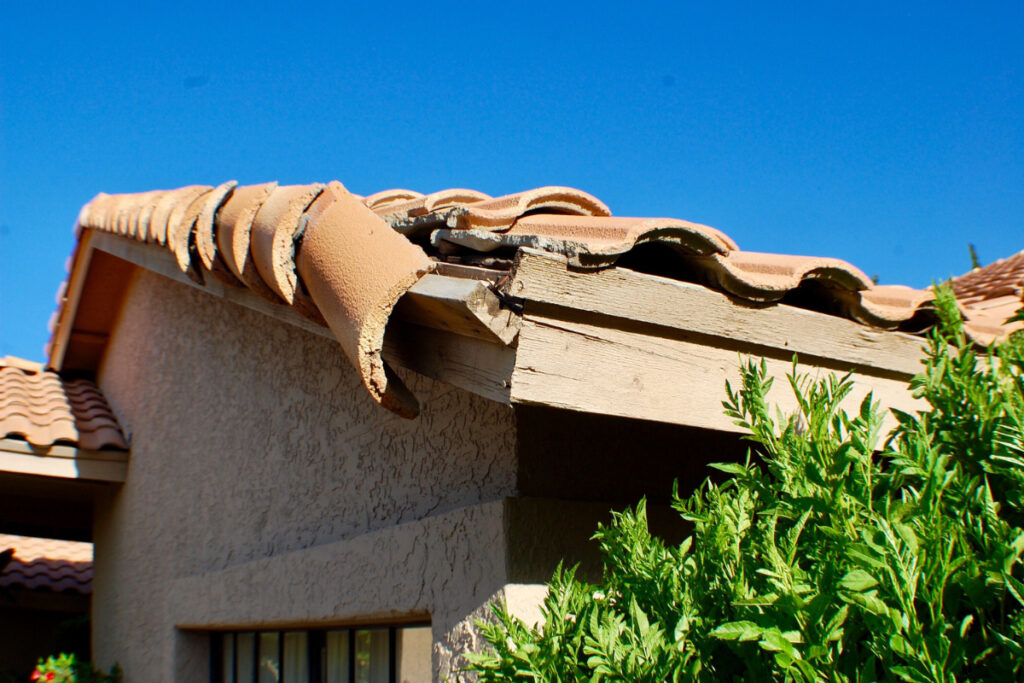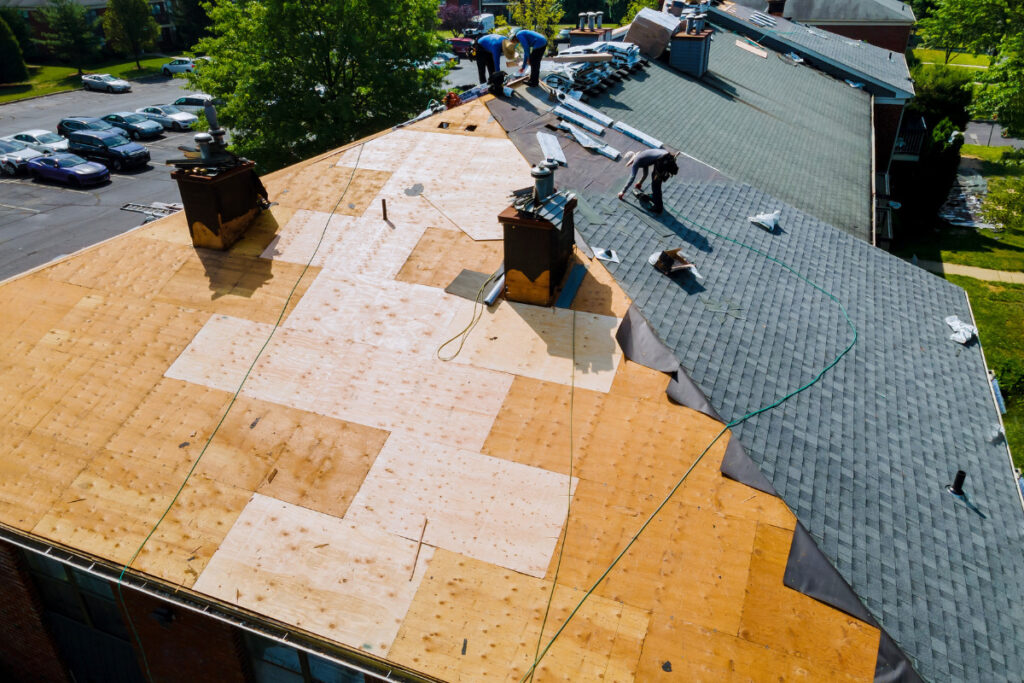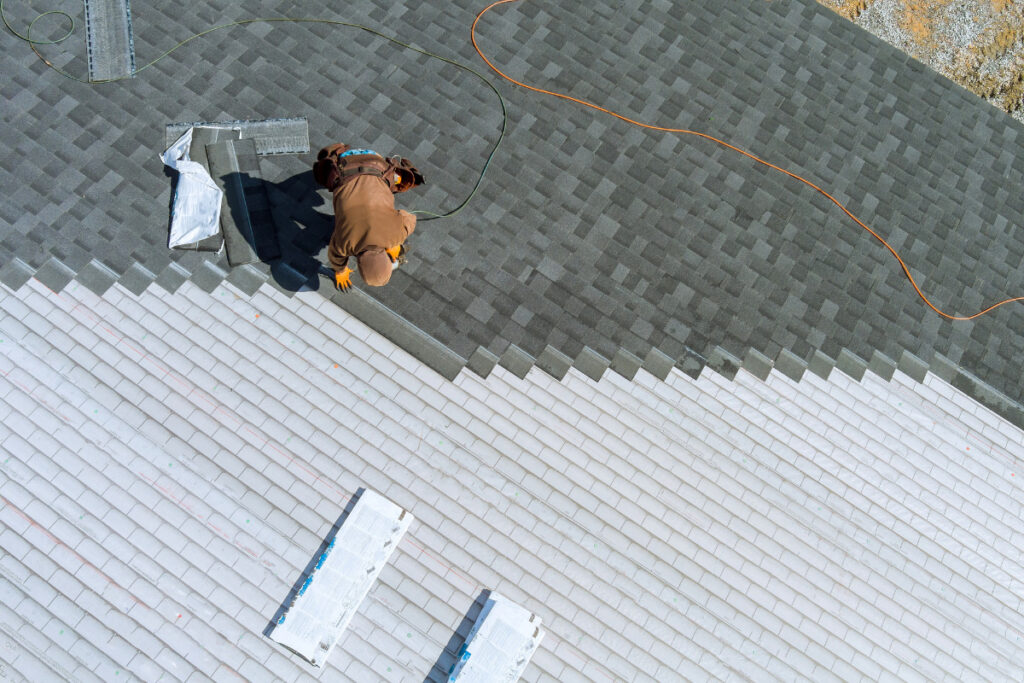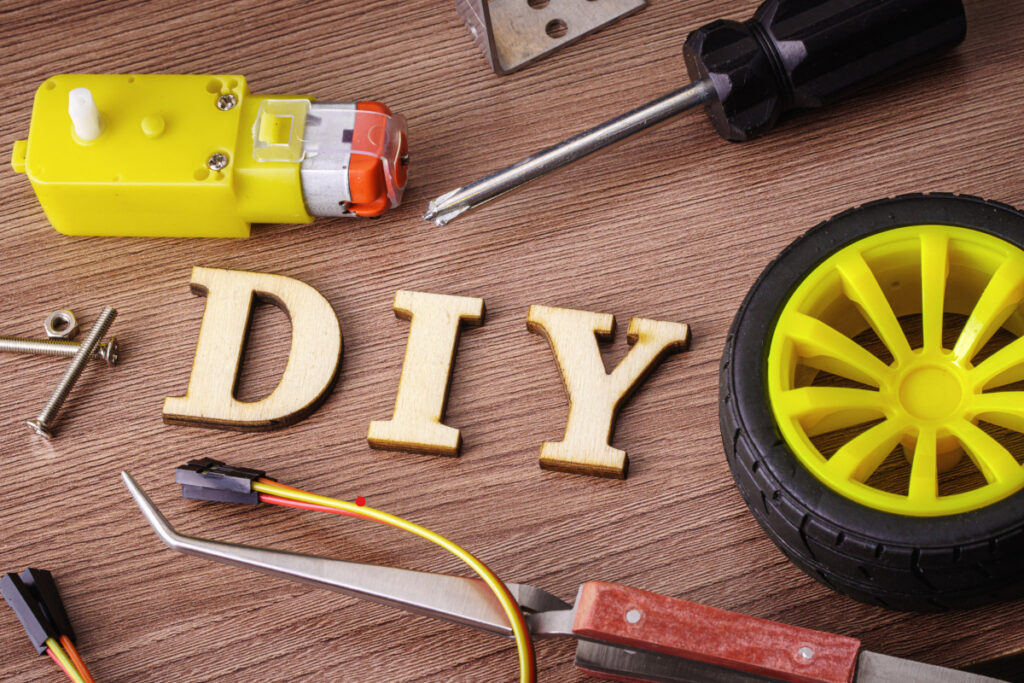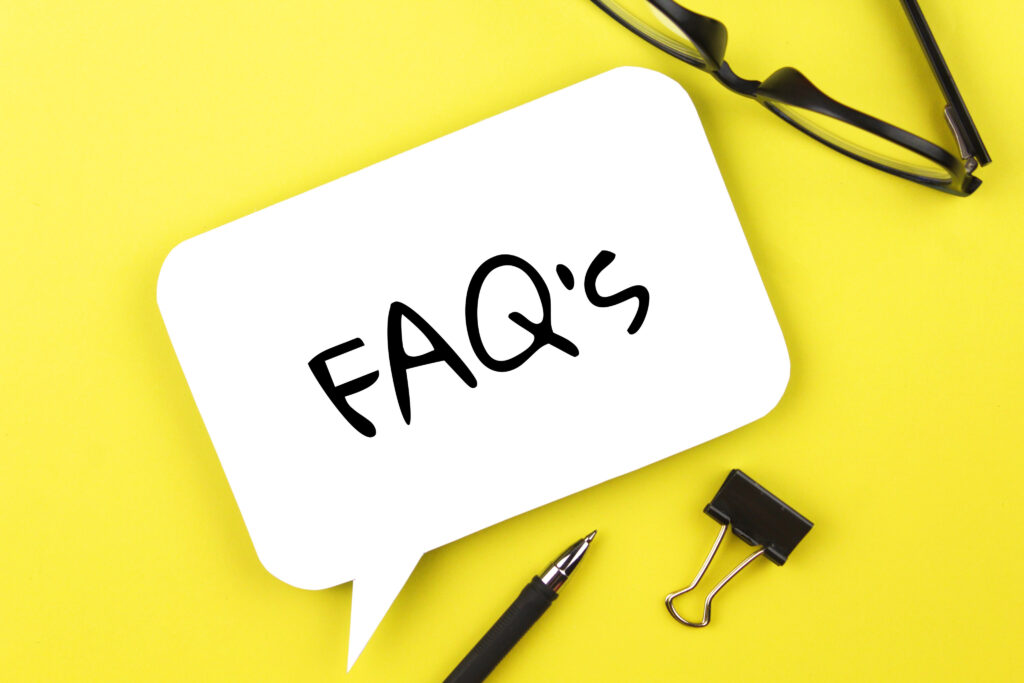Introduction
Dealing with the aftermath of a storm can be overwhelming, especially when deciding about your damaged roof. Choosing between repairing or replacing your roof is not always straightforward and requires careful consideration of various factors.
In this blog post, we’ll explore common types of storm damage. And the essential elements to weigh when deciding whether to repair or replace your roof. Read on to make an informed decision that protects both your home and wallet for years to come.
Understanding Storm Damage To Roofs
Storm damage to roofs can take many forms, including missing shingles, dented or cracked tiles, leaks, and water damage. It is essential to assess the extent of the damage as soon as possible after a storm to prevent long-term structural issues and potential safety hazards.
Common Types Of Damage
Storm damage to roofs can manifest in various ways, affecting the overall integrity and longevity of the roofing system. Some common types of roof damage caused by storms include:
- Leaks: Heavy rain or hail can lead to water penetration. This can result in leaks that cause stains and rot in the interior structure.
- Missing or damaged shingles: High winds can loosen or remove shingles, even if they are new and securely installed.
- Curling edges: Prolonged exposure to wind and moisture may cause the edges of shingles to curl, making them susceptible to further damage.
- Cracked shingles: Hailstorms can create cracks in shingles, weakening roofing material and potential leaks.
- Damaged flashing: Flashing is vital for preventing water intrusion at roof penetrations like vents and chimneys; storm damage may cause this component to become displaced or damaged.
- Issues with chimneys, soffit, and fascia: Storms can also harm other parts of your roofing system, such as chimneys becoming cracked or leaning, as well as damaged soffit and fascia boards which may allow water infiltration into your attic space.
- Rot and mold growth: Untreated leaks from storm damage can lead to wood rot and mold growth within your home’s structure, threatening your property’s value and your family’s health.
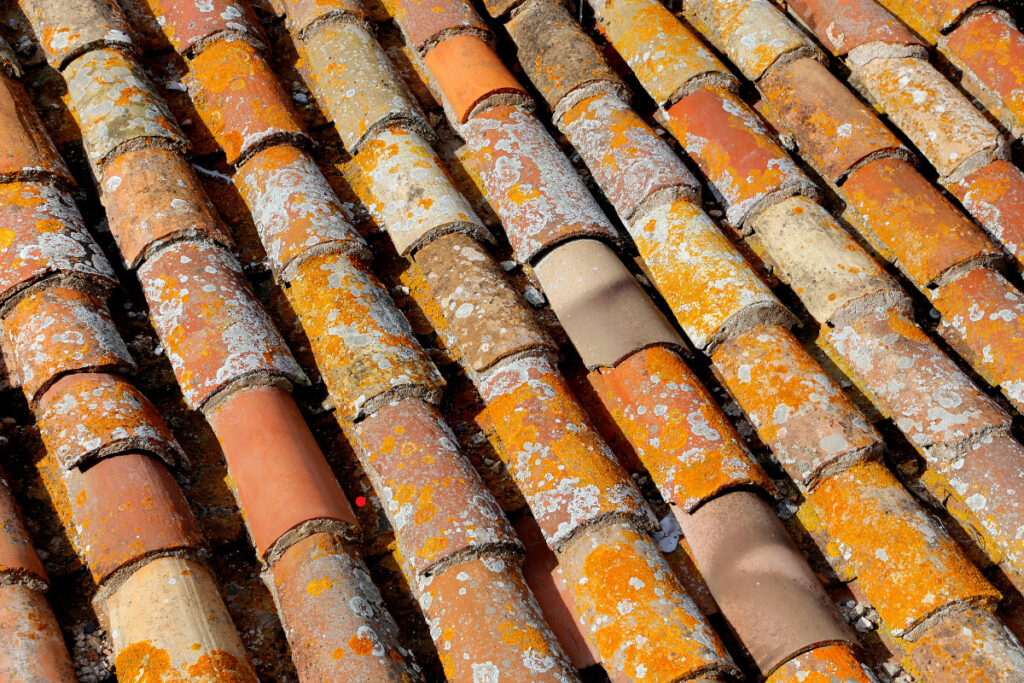
Causes Of Storm Damage
Storm damage to roofs can occur due to several factors, including high winds, heavy rainfall, hail, and even the impact of falling trees or debris. High winds are particularly damaging because they can potentially uplift shingles or other roofing materials from their proper placement. For example, loose or missing shingles indicate that strong wind gusts may have dislodged them during a storm. This can lead to aesthetic damage and functional issues as water leaks into your home.
Heavy rain damages roofs by pooling on flat surfaces, weakening structures, and causing possible collapse. Moisture from rainfall may seep into homes and cause mold or structural rot. Hurricanes or tornadoes can require complete roof replacement due to extensive damage.
Hailstorms can damage roofs extensively as the hailstones can be big enough to cause dents in metal sheets and crack asphalt shingles. Solar panel owners may also face problems as damaged equipment can limit the functionality of solar panels, reducing the power available for daily activities such as driving electric vehicles. Additionally, this damage can reduce the property’s overall value due to the equipment’s unsightly cosmetic appearance.
By understanding the common causes of storm-related roofing issues, homeowners can better prepare for inclement weather. Early assessment of potential threats can mitigate risks and prevent long-lasting consequences.
Importance Of Timely Assessment
When a storm happens, it’s very important to promptly assess your roof’s condition to determine the extent of damage caused by weather elements. The reason is that even minor damages can lead to more significant issues if not adequately addressed. For instance, leaks may increase in size over time and cause more damage to your home’s interior walls or ceiling.
Employing professional roofing services is crucial in conducting an accurate and thorough inspection after a storm. Professional inspections can identify hidden problem areas not visible to the naked eye, such as water intrusion that would require immediate repair efforts. Without timely assessments, you run the risk of costing yourself unnecessary additional expenses down the line.
If you’re considering installing solar panels on a damaged roof without inspection, it may be unsafe or ineffective due to existing structural issues. A professional roofing service will assess your entire roof system, make recommendations based on experience, and consider the number of solar panels for maximum efficiency on a new roof replacement.
Assessing Storm Damage: Repair Or Replacement?
When deciding whether to repair or replace a storm-damaged roof, there are several factors to consider, including the severity of the damage, cost-benefit analysis, and insurance coverage.
Factors To Consider
When deciding whether to repair or replace your storm-damaged roof, there are several important factors to consider:
- Severity of Damage: Assess the extent of damage and identify if it’s a minor or major issue.
- Age of Your Roof: Determine the age of your current roof, as this can affect its lifespan and the cost-effectiveness of future repairs.
- Type of Roof: The type of roofing material you have will impact your repair or replacement decision and determine your roof’s durability.
- Cost-Benefit Analysis: Consider the costs of repairing versus replacing your roof, including any potential insurance coverage, and weigh them against each option’s benefits.
- Long-Term Ownership Plans: If you plan on owning your property for a long time, then investing in a replacement may be more cost-effective than recurring repairs.
- Aesthetic Considerations: Evaluate if repairing or replacing your storm-damaged roof will affect your property’s appearance or curb appeal.
- Environmental Factors: Energy efficiency may be necessary when deciding between repair and replacement, especially with new sustainable roofing materials on the market.
- Future Storms: Consider reinforcing and upgrading your roofing system to better withstand future storms, which could prevent costly repairs.
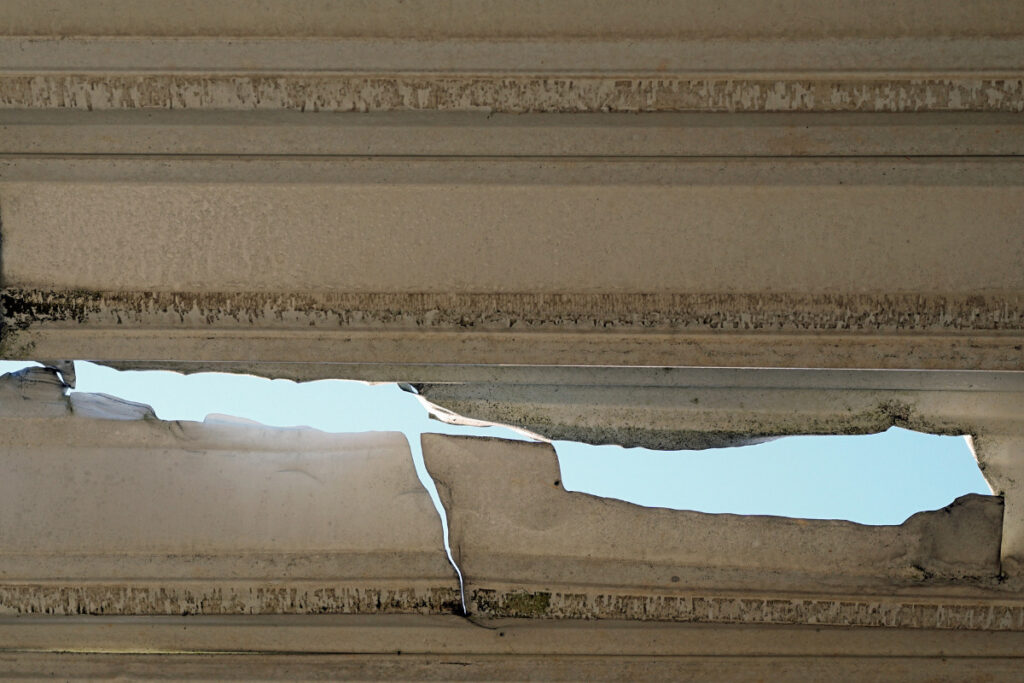
Cost-Benefit Analysis
When assessing your storm-damaged roof, it’s crucial to do a cost-benefit analysis of repairing or replacing it. Factors such as labor costs, roofing materials, and insurance coverage should be considered. For example, if you have an older roof that requires frequent repairs and has suffered severe storm damage, it might make more sense financially to replace the entire roof instead of continually repairing it.
In addition to cost considerations, other factors must be weighed when deciding whether to repair or replace your damaged roof. One aspect is building code requirements. In Florida, for instance, there’s a 25% rule regarding roof replacement or recovery—the law mandates compliance with the Florida Building Code if more than 25% of a section of the root needs replacement. This makes knowing local laws relevant in estimating costs and deciding how much revamping will cost.
Any challenging decision-making process must weigh multiple factors when determining whether to go for costly repairs versus complete replacement. Deliberate steps are necessary, but ultimately wise financial planning could save both time and money on an overall investment that directly impacts property values going forward in decades ahead— one never knows what natural disasters may come next!
Insurance Coverage
Insurance may cover storm damage to your roof depending on your policy terms and the cause of damage. But generally, most homeowners’ insurance policies cover repairs or replacements for this type of damage.
Take photos of storm damage to your roof right away to ensure coverage. Contact your insurance company promptly to have an adjuster assess the damage and provide an estimate for repairs or replacement. Homeowners’ insurance may only partially cover storm-related roof repair or replacement if the policy excludes certain weather events, like flooding.
Benefits Of Repairing A Storm-Damaged Roof
Repairing a storm-damaged roof provides cost savings, extends the lifespan of your roof, and preserves your property’s aesthetics.
Cost Savings
One of the advantages of repairing a storm-damaged roof is cost savings. Repairs are often more budget-friendly than a complete replacement and can help you avoid unnecessary expenses. The costs associated with restoring your roof will depend on several factors, such as the extent of damage, roofing material, and labor costs. For example, replacing shingles or patching up leaks may be less expensive than buying and installing an entirely new roof. Additionally, if your insurance policy covers storm damage repair costs in full or part, you could save money by not having to pay out-of-pocket.
If cost is your primary concern after storm damage to your roof, opting for repairs rather than replacements might be the best choice. However, it’s important to note that while repairs may seem cheaper at first glance, they could cost more in the long run if further damages occur due to temporary fixes that do not address underlying issues. A professional roofing service can assess the situation and provide a detailed estimate for repair and replacement options so that homeowners can weigh all their choices before making any decisions regarding their roofs’ maintenance needs.
Extended Lifespan Of Your Roof
Repairing a storm-damaged roof can extend the lifespan of the existing roof, saving homeowners money in the long run. When damage is not severe and limited to just a few shingles, repairing rather than replacing may be sufficient. A professional roofing contractor can assess whether your roof is structurally sound and provide you with options that suit your budget.
Simple actions such as clearing debris from gutters, trimming overhanging branches, and checking for water leaks are small steps but significant in protecting your investment. Furthermore, regular maintenance can also help improve the longevity of your roof. With proper care and attention to repairs, a well-maintained durable roof may last up to 30 years or more.
In addition to prolonging the lifespan of their roofs, homeowners who repair instead of replace storm-damaged roofs also retain their property’s aesthetic appeal while avoiding costly upgrades or total replacements. Keeping up with minor repairs means fewer major overhauls down the line, which ultimately saves homeowners time and money in managing more significant roofing issues should they occur later on.
Preservation Of Property Aesthetics
When considering whether to repair or replace a storm-damaged roof, it’s important to consider preserving property aesthetics. A damaged roof can significantly impact the overall appearance of your home and may even affect its value. This is especially true for high-end properties with unique architectural designs that require specific roofing materials.
For example, if your property has a historic Victorian-style design with elaborate roofing materials such as slate or clay tiles, replacing damaged areas instead of opting for an entirely new roof can maintain its original character and charm. Additionally, repairing damage promptly can prevent further deterioration and avoid more extensive repairs.
If large roof sections have significant damage, replacing them may be necessary for design continuity and improved home appeal. Whether you choose to repair or replace your roof, consulting professional contractors specializing in preserving aesthetics is crucial for quality workmanship and results that meet both function and aesthetic needs.
Benefits Of Replacing A Storm-Damaged Roof
Replacing a storm-damaged roof provides improved energy efficiency, increased property value, better durability and resistance to future storms, and an opportunity to upgrade roofing material.
Improved Energy Efficiency
One of the significant benefits of replacing a storm-damaged roof is an improvement in energy efficiency. With technological advancements, today’s shingles are designed to do more than just keep a house dry; they can also contribute to energy savings. Options such as cool roofs, which reflect sunlight and heat away from home, and solar panels, which generate electricity from the sun’s rays, can significantly reduce a homeowner’s carbon footprint while lowering their monthly utility bills.
In addition to choosing roofing materials that promote energy efficiency, homeowners can improve their roof’s performance in other ways. Proper insulation and attic ventilation can prevent heat loss during colder months and help keep living spaces cool in warmer weather. Homeowners should also consider upgrading or repairing damaged flashing around chimneys and vents and sealing leaks around skylights or air ducts to improve their roof’s energy efficiency.
When deciding whether to repair or replace a storm-damaged roof, the potential for improved energy efficiency should be considered alongside other important factors such as cost-benefit analysis and insurance coverage. By investing in an energy-efficient roofing system when replacing their damaged roof, homeowners can save money on utility bills and increase the overall value of their homes.
Increased Property Value
A new roof enhances curb appeal and adds significant value to a home, making it more attractive to potential buyers. Replacing a storm-damaged roof can allow homeowners to increase their property’s value. For example, according to Remodeling Magazine’s 2020 Cost vs. Value report, replacing an asphalt shingle roof with a metal one could provide up to a 60% return on investment.
Homes with energy-efficient features are becoming increasingly popular among homebuyers because they help reduce utility bills and minimize the property’s environmental impact. Moreover, installing sustainable and energy-efficient roofing materials can further boost property value. For instance, solar panels or cool roofs can significantly enhance energy efficiency and make homes more desirable in areas prone to high temperatures.
In conclusion, replacing a storm-damaged roof can benefit homeowners by improving their home’s aesthetics while adding overall value through sustainable materials that enhance energy efficiency while lowering costs over time.
Better Durability And Resistance To Future Storms
Replacing a storm-damaged roof can provide better durability and resistance to future storms. This is because the new materials used for replacement are often more advanced and designed to withstand extreme weather conditions. For instance, you can opt for impact-resistant shingles that have passed rigorous Underwriters Laboratories (UL) testing and help protect your home against hail damage. Additionally, metal roofs offer excellent protection against high winds expected in storms as they interlock tightly with one another, making them less likely to detach during extreme weather.
Investing in a new roof means better durability and resistance to future storms. Upgrade options such as impact-resistant shingles, metal roofs with interlocking panels, and adding reinforcements with hurricane clips ensure stronger protection from strong winds associated with hurricanes or thunderstorms. Opting for these improvements during replacement helps minimize the risks of significant damage when another storm eventually hits your area again.
Opportunity To Upgrade Roofing Material
Another benefit of replacing a storm-damaged roof is the opportunity to upgrade your roofing material. Modern roofing materials offer better durability, resistance to future storms, and improved energy efficiency. For example, metal roofs are becoming increasingly popular due to their long lifespan and energy-saving properties. They reflect heat well, reducing the need for air conditioning in hot climates.
Additionally, upgrading your roofing material can increase the value of your property. Homebuyers often look for homes with energy-efficient features like solar panels or cool roofs when shopping for a new home. Investing in an upgraded roofing material could pay off in the long run if you decide to sell your property later.
Finally, some homeowners opt to replace their damaged roofs with sustainable and environmentally friendly options such as green roofs or solar tiles, which harness renewable solar power while benefiting wildlife by providing habitats for birds, insects, and other animals right on top of their homes!
When To Repair Your Storm-Damaged Roof
If your roof has only minor damage and you have a limited budget, repairing the storm damage could be a more reasonable option. However, remember that this decision should be based on several factors, such as the age of your roof and its overall condition. Read on to learn more about assessing storm damage and making informed decisions about repairing or replacing your damaged roof.
Minor Damage
Minor damage to a storm-damaged roof may include missing or cracked shingles, small leaks, or minor dents. In most cases, repairing such damages is the best option. This is especially true if your roof is relatively new and you plan on selling your property soon.
Minor repairs can help extend the lifespan of your roof without affecting its structural integrity. However, it’s essential to remember that even seemingly minor damage can worsen over time if addressed. Therefore, prompt repairs are crucial for avoiding costly replacements down the road.
As a homeowner, you should consider your budget when repairing or replacing your storm-damaged roof. If funds are limited and the damage is minor enough to be fixed within budget limits, then choosing a repair will be an optimal choice for you as this leads to cost savings while preserving property aesthetics at the same time.
Recent Repairs
A new roof can help prevent future costly repairs and improve your property’s aesthetics. If your roof has recently undergone repairs, you may be able to get away with repairing any storm damage it sustained. However, the extent of the repair and how recent it was will determine whether or not this is a viable option. If your roof has had several repairs over a short period, replacing it may be more cost-effective in the long run.
It’s important to remember that minor storm damage on a recently repaired roof can still lead to significant issues if left unaddressed. Timely assessment after every severe weather event is crucial since more minor problems like cracks or leaks can worsen if ignored for too long. In such cases, repairing these particular areas immediately could prolong the lifespan of your current roof without needing an entire replacement anytime soon.
Short-Term Ownership Plans
Repairing a storm-damaged roof may be more practical if you plan to sell your house shortly. Minor leaks or missing shingles can be resolved quickly and affordably without requiring extensive work. With short-term ownership plans, investing in a complete replacement may offer less return on investment than simply fixing any damages.
With limited time left on your property, consider consulting with a professional roofing contractor for their expert opinion on whether the repair is feasible, how much it will cost, and if it’s worthwhile, given your timeframe.
You’ll need to keep track of any repairs made so potential buyers are informed about the roof’s state when they make an offer. Taking steps towards preserving its appearance could also help increase property value should you decide to replace it further down the line before selling.
Limited Budget
When considering a limited budget for storm damage repairs, it’s essential to weigh the cost-benefit analysis of repairing versus replacing your roof. If the damage is minimal and you have a tight budget, repairing may be the better option. For instance, fixing these issues can save you money in the short run if there are only small leaks or missing shingles after a storm with no significant structural damage.
However, delaying necessary repairs due to financial limitations may cost more in the long term. This is especially true since minor leaks can become major structural damages over time, resulting in additional costs. It’s important to make an informed decision considering immediate and future expenses when working with a limited budget.
Consider consulting with roofing professionals to cut costs while ensuring quality repairs within your budget. You can also opt for financing options such as loans or payment plans offered by some contractors so that repairs don’t break your bank account immediately.
When To Replace Your Storm-Damaged Roof
Replace your storm-damaged roof if the damage is severe, the roof is old and nearing its expected lifespan, frequent repairs have been necessary for recent years, you plan on owning the property for a long time, and/or you have an adequate budget to finance a replacement.
Severe Damage
If your roof has severe damage after a storm, such as large holes, extensive leaks, or missing shingles, the decision to repair or replace should be made carefully. In most cases of severe damage, replacing the entire roof is recommended rather than attempting a repair that may not completely fix the issue. Severe damage can make your home susceptible to further water and structural damage if not properly addressed.
Ignoring severe storm damage to your roof can lead to much more significant problems in the long run. If you don’t repair a severely damaged roof, water leaks can cause mold growth and additional expenses later. You may be eligible for full replacement cost coverage if your insurance covers storm damages. The decision to repair or replace your roof depends on various factors, including your budget, the age of the existing roof, and getting expert opinions from reputable roofing professionals in your area who understand local building codes.
Old Age Of Your Roof
A complete replacement may be best if your roof is over 20 years old and has sustained significant storm damage. Shingle roofs typically have a lifespan of 15-20 years, and an older roof can weaken over time, making it more susceptible to storm damage. Additionally, some insurance companies may not cover the cost of replacing an entire roof that’s older than 20 years.
However, repairing the damaged sections may be sufficient if the damage is minor and your shingle roof is only a few years old. It’s essential to assess the damage’s severity and the roof’s age when deciding between repair or replacement. In addition to age and damage assessment factors, homeowners should consider their long-term ownership plans and budget before opting for either repair or replacement services.
Frequent Repairs
If your storm-damaged roof requires frequent repairs, it may be time to consider a complete replacement. Frequent repairs can quickly become expensive and can ultimately cost more than a complete roof replacement in the long run. If you find yourself constantly calling for repairs or patching up leaks, it’s a sign that your roof is no longer functioning as it should.
Additionally, frequent repairs can indicate underlying issues with your roof’s structure or materials. Ignoring these problems could result in more extensive damage to your property’s interior and exterior over time. It’s important to take action before the damage becomes irreparable.
When deciding whether to repair or replace after frequent repairs, consider the age and condition of your existing roof. If it’s approaching its lifespan or has undergone numerous rounds of repair work, replacing it will likely provide greater benefits and cost savings in the long term compared to continued temporary fixes.
Long-Term Ownership Plans
Considering your long-term ownership plans is crucial when deciding whether to repair or replace a storm-damaged roof. A new roof will provide better durability and resistance to future storms and increase the overall value of your property. If you plan on living in your home for many years, replacing the damaged roof may be the better option.
Regardless of whether you choose to repair or replace as a solution for storm-damaged roofs with long-term ownership plans, hiring professional roofing services is always recommended. A qualified contractor can assess the damage accurately and recommend solutions that fit short- and long-term goals while ensuring safety standards are met.
Adequate Budget
An adequate budget is critical when repairing or replacing a storm-damaged roof. While repairing may seem more cost-effective, sometimes the extent of damage makes replacement the only viable choice. Replacing your roof can be expensive. It’s important to consider long-term benefits such as increased property value and energy savings. It also allows upgrading roofing materials for better durability and resistance against future storms.
When deciding based on budget, it’s essential to factor in additional costs that come with each option. Repairing a damaged roof incorrectly can lead to frequent, costly repairs in the long run. Replacing your old roof can save money by eliminating recurring repair expenses and providing long-lasting protection.
Hiring Professional Roofing Services
Hiring a qualified roofing contractor to repair or replace your storm-damaged roof is crucial.
Importance Of Hiring A Qualified Contractor
When it comes to repairing or replacing your storm-damaged roof, hiring a qualified contractor is of utmost importance. Hiring a professional roofer isn’t just about their expertise; it’sChoosing a reliable roofer is crucial. Choosing a qualified roofing company requires asking various questions about their licensing, certifications, experience, and workmanship warranties. Also, about your safety during repairs. Plus, a trustworthy contractor can make a big difference in the value of your home and roof investment over time.
Choosing a qualified roofing company requires asking various questions about their licensing, certifications, experience, and workmanship warranties. Choosing a reliable roofer is crucial. You can do this by asking for references from satisfied customers and a written estimate. By taking these steps, you’ll make an informed decision and avoid scams or amateur contractors that can cause more harm than good.
How To Choose The Right Roofing Company
Choosing the right roofing company is crucial when repairing or replacing your storm-damaged roof. Here are some steps to take when selecting a reliable and qualified contractor:
- Check for licenses and certifications: Ensure the roofing company you choose is licensed, insured, and certified by reputable organizations such as the National Roofing Contractors Association (NRCA).
- Read online reviews: Look up the roofing company online and read reviews from previous customers to understand their reputation.
- Consider local contractors: Local contractors are familiar with your area’s weather patterns and can offer recommendations based on your location’s specific needs.
- Get multiple estimates: Obtain written estimates from different roofing companies, comparing prices and services offered.
- Look for warranties and guarantees: Ask about warranties or guarantees offered for the products used in repairing or replacing your roof.
- Ask for referrals: Talk to friends, family members, or neighbors who have recently had roofing work done, and ask for referrals to trustworthy contractors they’ve worked with before.
Remember that choosing the right roofer involves more than finding the lowest price. Safety, quality of workmanship, and use of high-quality materials should all be considered when selecting a contractor.
Checking For Licenses And Certifications
When hiring a roofing contractor, checking for licenses and certifications is crucial. These credentials signify that the company has met certain standards and regulations. A general contractor’s license is essential for ensuring quality workmanship, as this demonstrates that the roofer has passed an exam and met specific requirements at the state or local level. Additionally, verifying insurance certificates can give you peace of mind should any accidents occur during the job.
It’s important to be wary of “storm chasers” who may try to take advantage of homeowners needing quick repairs after a storm. These contractors often lack proper licensing and certification, so it’s wise to research before hiring anyone. Asking for references from past customers or checking online reviews can also help potential vet roofers.
By thoroughly researching a roofing company before hiring them, you can rest assured that you’re making an informed decision about who will work on one of your most valuable assets – your home.
Requesting A Written Estimate
When repairing or replacing your roof after a storm, requesting a written estimate from the roofing company is important. A written estimate should include removing the old roof, new roof specifications, and drip edge installation. A qualified roofing contractor will provide an accurate and detailed estimate outlining all costs of your roofing project.
Getting a detailed written estimate is crucial to understand what services are included in the price. You don’t want surprises when it comes time to pay for your repair or replacement services. Ask questions and clarify discrepancies before signing on with a contractor. Additionally, getting references from contractors before making a decision is always helpful in ensuring that you’re hiring someone reliable who can deliver quality workmanship at an affordable price point.
DIY Roof Repairs: Do’s And Don’ts
Learn safe DIY roof repair tips and the types of projects that can be done without professional help. But be cautious. Not all repairs should be tried on your own, unfortunately. You can learn more about tackling minor roof repairs while avoiding costly mistakes.
Safe DIY Roof Repair Tips
Repairing your roof can be a daunting task. But it can be done safely and effectively with the right tools and knowledge. Here are some safe DIY roof repair tips:
- Wear appropriate safety gear: Always wear proper safety gear when working on your roof. Such as gloves, eye protection, and sturdy shoes with good traction.
- Choose the right ladder: Use a sturdy ladder that is tall enough to comfortably reach the area you need to work on. Be sure to place it on a stable surface.
- Stay aware of electrical hazards: Avoid working near power lines or if there’s a risk of lightning.
- Assess weather conditions: Avoid working on your roof during bad weather conditions such as high winds or extreme temperatures.
- Work on a dry roof: Wait for the roof to dry out completely before starting any repairs.
- Be cautious when using tools: Remember to use your tools responsibly and carefully so as not to cause any further damage.
- Follow manufacturer instructions: For best results, follow manufacturer instructions when applying roofing materials such as sealants or adhesive tape.
- Ask for help when necessary: If you need clarification, seek professional advice from roofing experts.
By following these tips and exercising caution, you can safely repair your roof and avoid costly damages.
Types Of DIY Roof Repair Projects
If you decide to repair your storm-damaged roof on your own, keep in mind the following types of DIY roof repair projects:
- Fixing small leaks: You can use roofing cement or sealant to fix minor leaks before they become major ones.
- Replacing shingles: If only a few shingles are damaged or missing, you can replace them yourself using a pry bar, hammer, and nails.
- Clearing debris: If branches or other debris are on your roof after a storm, carefully remove them yourself with a ladder and gloves.
- Gutter cleaning: Clear out any debris that may have accumulated in your gutters after a storm to prevent water damage to the roof.
However, it is crucial to note that not all roofing issues can be fixed by yourself. Hiring professional roofing services may be necessary for larger or structural repairs. Moreover, attempting major repairs on your own could result in further damage to your roof and void warranties from manufacturers.
When To Avoid DIY Roof Repairs
Although DIY repairs can be cost-effective, it’s best to hire a professional roofing company when severe storm damage occurs. Attempting repairs on your own can be dangerous and lead to further damage. Call experts with the proper equipment and knowledge to handle these situations safely.
Another scenario where DIY repair may not be recommended is when dealing with an old or deteriorated roof. Older roofs require specific techniques and expertise that most homeowners lack. In addition, trying to repair an older roof yourself increases the risk of damaging the materials underneath or voiding any warranties attached to them. If you need clarification about how old your roof is or if it’s showing signs of wear and tear, please consult a roofing professional before attempting any repairs.
Preparing For Future Storms
Preparing your roof for future storms is crucial to maintaining and reinforcing it, exploring sustainable and energy-efficient roofing options, and considering various financing options. Don’t let another storm catch you off guard; read on to learn how to protect your home from damage.
Maintaining And Reinforcing Your Roof
Maintaining and reinforcing your roof is vital to ensure its longevity and durability, especially after it has been damaged by a storm. Here are some ways to maintain and strengthen your roof:
- Regular Cleaning: Clean your roof periodically. Remove debris like leaves, branches, and dirt that can cause water buildup and block the flow of rainwater.
- Inspect for Damage: Inspect your roof for missing or cracked shingles, flashing, or lose gutters. Repair any damage promptly.
- Reinforce with Hurricane Straps: Install hurricane straps on the joists or trusses of your home to provide extra reinforcement to the roof during high winds.
- Seal Leaks: Check for leaks in your attic or ceiling and seal them with roofing cement or silicon caulking.
- Trim Trees Near Your Roof: Overhanging branches can damage your roof during storms. Trim branches near your home’s roof.
- Reinforce Windows and Doors: Install impact-resistant windows and doors or cover them with shutters or plywood to prevent flying debris from damaging your roof during a storm.
- Proper Ventilation: Ensure proper ventilation in the attic space. This prevents moisture buildup that can cause mold growth and weaken the roof’s structure.
Following these maintenance tips, you can keep your roof in good condition for extended periods. While also ensuring it better withstands extreme weather conditions such as storms and hurricanes.
Sustainable And Energy-Efficient Roofing Options
Sustainable and energy-efficient roofing options are an excellent investment for property owners who want to prepare for future storms while reducing energy costs. Here are some sustainable and energy-efficient roofing options to consider:
- Cool Roofs – Cool roofs are made from materials that reflect sunlight and absorb less heat than traditional roofs. By installing a cool roof, homeowners can reduce their interior temperatures by up to 30%, lowering cooling costs.
- Green Roofs – A green roof is partially or entirely covered in soil or other growth media vegetation above a waterproof membrane. Not only do green roofs help with stormwater management, but they also provide additional insulation, reducing heating and cooling needs.
- Metal Roofing – Metal roofing is durable and recyclable, making it an eco-friendly option. Additionally, metal roofs can be coated with UV-reflective finishes, which increase energy efficiency.
- Solar Tiles – Integrating solar panels into roofing tiles has become increasingly popular as technology advances. Not only do solar tiles generate electricity, but they also offer all the benefits of a traditional roof.
By choosing one of these sustainable and energy-efficient roofing options, property owners can reduce their carbon footprint. And also save on their utility bills while preparing for future storms.
Financing Options For Repairs Or Replacement
If you don’t have homeowner’s insurance covering roof repair or replacement costs, financing options are still available. Personal loans, home equity loans, and even financing through a reputable roofing company are all choices to consider. Personal loans may be helpful if you have good credit and can quickly repay the loan. Home equity loans allow you to borrow against your home’s value and may offer lower interest rates than personal loans. Financing through a roofing company could also provide flexible payment plans to help make the costs more manageable.
It’s important to remember that financing comes with its own set of pros and cons. Borrowing money means paying it back with interest, so consider whether borrowing suits your situation. Additionally, not all financing options suit every budget or timeline for repair or replacement. Think about upfront costs and repayment terms when choosing a financial plan.
The decision to repair or replace storm-damaged roofs should not be taken lightly. Factors such as age, the severity of the damage, and budget must all be considered before making a final decision. Fixing a damaged roof saves money, but replacing it boosts energy efficiency and property value in the long run.
Whether you opt for repairs or replacement, hiring a professional roofing company is crucial for ensuring quality workmanship and safety. Protect your roof investment and the environment with safe DIY repair tips and sustainable options like green roofs and solar panels for future storms.
Remember to always prioritize safety when dealing with any kind of roof damage. The decision to repair or replace may seem daunting. Consider these factors and seek advice from qualified contractors to make an informed and budget-friendly choice for your home.
Conclusion
The decision to repair or replace storm-damaged roofs should not be taken lightly. Factors such as age, the severity of the damage, and budget must all be considered before making a final decision. While repairing a damaged roof may save you money in the short term, replacing it has long-term benefits such as improved energy efficiency and increased property value.
Whether you opt for repairs or replacement, hiring a professional roofing company is crucial for ensuring quality workmanship and safety. By following safe DIY roof repair tips and preparing your roof for future storms with sustainable options like green roofs or solar panels, you can protect your investment while also reducing your carbon footprint.
Remember to always prioritize safety when dealing with any kind of roof damage. The decision to repair or replace may seem daunting, but by taking these factors into account and seeking professional advice from qualified contractors, you can make an informed choice that’s right for both your wallet and your home.
FAQs:
- What factors should I consider when repairing or replacing my roof after a storm?
Some important factors to consider include the extent of the damage, the age and condition of your current roof, and your budget for repairs or replacement. It may also be worth consulting a professional roofing contractor to determine the best action.
- How can I tell if my roof has sustained significant damage after a storm?
Significant damage may include missing shingles, cracks or dents in roofing materials, leaks inside your home, or visible signs of water damage on walls and ceilings. If you suspect your roof has been damaged during a storm, it is important to have it inspected by an experienced professional as soon as possible.
- Is replacing a damaged roof after a storm always necessary?
It depends on the extent of the damage and how long it has been since your last roof replacement. In many cases, more minor repairs can be made to correct issues such as missing shingles or minor leaks; however, more extensive repairs may require complete replacement to ensure optimal performance over time.
- What are some tips for selecting the right roofing contractor for my repair or replacement needs?
Choose roofing contractor based on experience, reputation (reviews), qualifications (licenses), pricing, and insurance coverage. Verify liability coverage for protection. Ensure contractors have adequate protections for onsite accidents.
